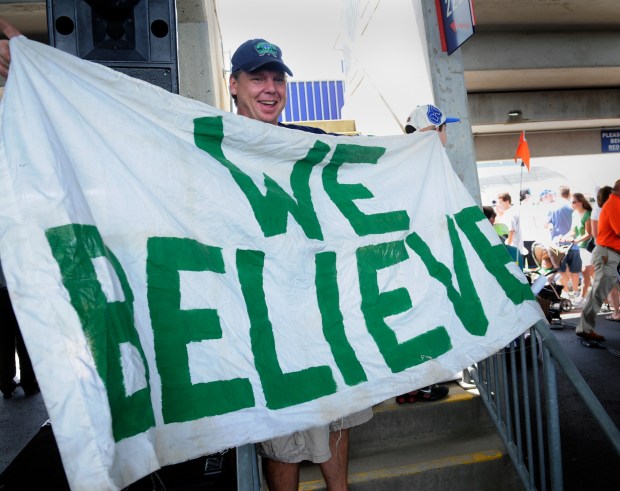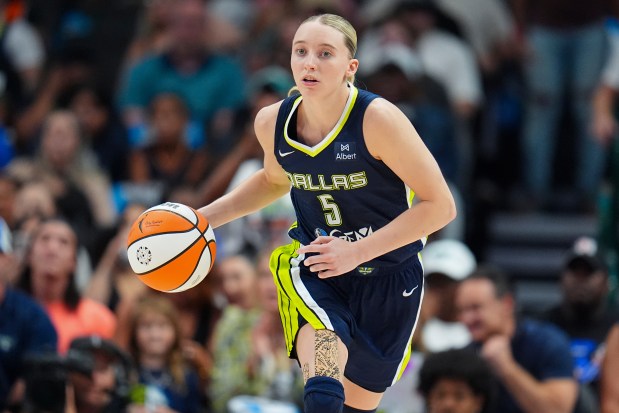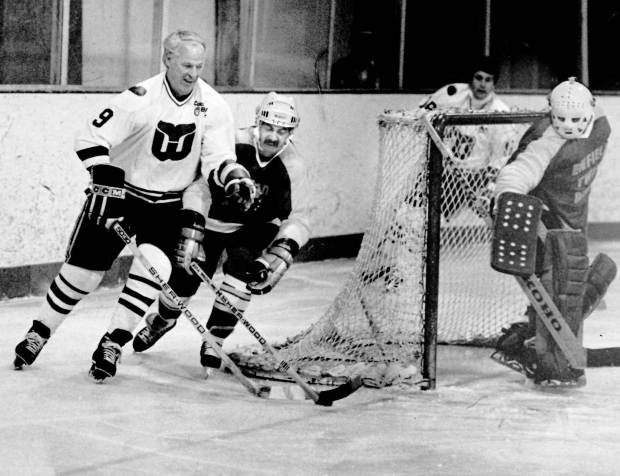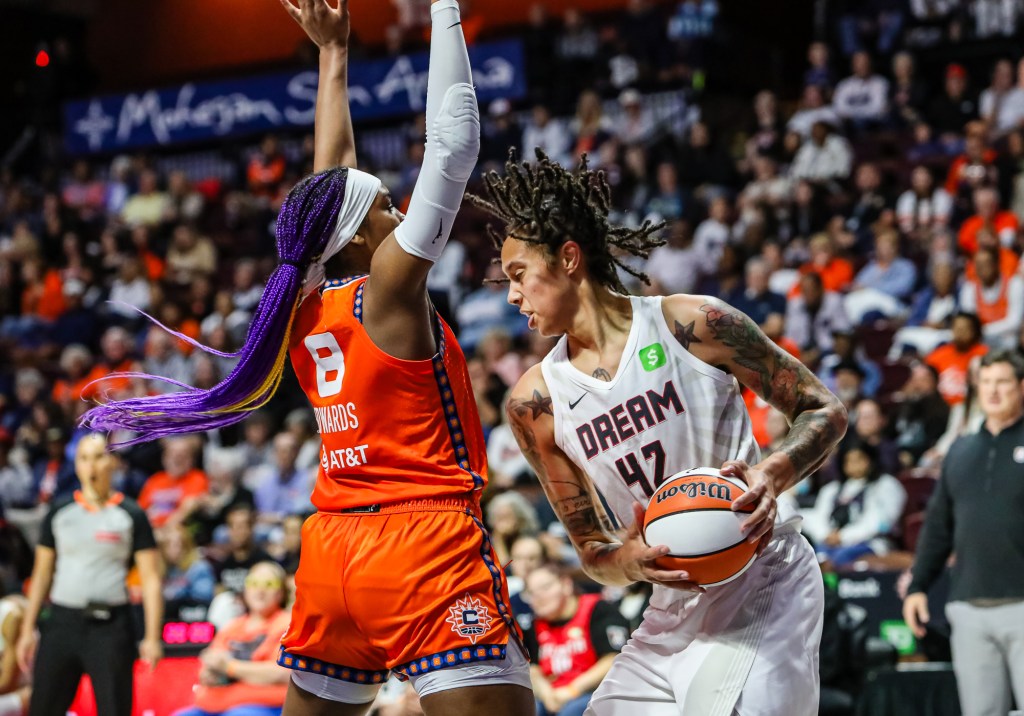Let’s say the quiet part out loud: when it comes to using public funds to subsidize private sports organizations that debate should not be part of this debate of relocating the Connecticut Sun to Hartford. It’s irrelevant.
For every economic study that says sports teams boost local economies, there’s another claiming they don’t. But here’s the truth: the right sports team can transform a city—not through spreadsheets or the number of beers sold post-game but through identity, energy, and visibility. Hartford knows this better than anyone. Call it “The Whalers Effect.”
The Original Whalers Effect
When Aetna and Howard Baldwin teamed up in 1975 to bring the Whalers to Hartford it wasn’t just because the city had an empty arena. The goal was to attract young executives and rebrand Hartford as a forward-thinking city on the rise. The corporate community saw the power of a professional sports—and private investment followed, including the Hartford Courant.

STEPHEN DUNN/Hartford Courant
EAST HARTFORD-2010- There was a sea of Whalers jerseys and Whale logos everywhere you looked during the Whalers Fan Fest held at Rentschler Field on Saturday. An estimated 5,000 die-hard Hartford Whalers fans converged on the stadium to wait in line for hours to have the former Whalers players sign autographs. In photo, Tim Kiro of East Hartford, a former Whalers season ticket holder, displays a banner which he carried on the last day of the Whalers stay in Hartford in 1997. STEPHEN DUNN|sdunn@courant.com
The Whalers never won a championship here, but they did something more important: they gave Hartford a major league identity.
PHOTOS: Hartford Whalers alumni share laughs at CT hospital visit
For more than four decades my agency, Elkinson + Sloves, has had a front row seat to sports and arts in Hartford. We helped bring the Hartford Yard Goats to Hartford—and yes, were also not part of the team that lost the Hartford Whalers. (Whalers ownership showed us the door when we disagreed with the Ron Francis trade, which was the beginning of the end of the Whalers reign here).
Hartford on the Global Stage
The second “Whalers Effect” was visibility. Each game broadcast — 82 nights a year — carried Hartford’s name and across the biggest media at the time including ESPN, CBS Sports, the New York Times, USA Today, LA Times, Chicago Sun-Times, Montreal Gazette, Toronto Star, and beyond.
You simply couldn’t buy that kind of exposure. Suddenly Hartford wasn’t the forgotten city between New York and Boston — those cities came to us. World-class corporations, conferences, and events followed, including the NHL All-Star Game, Davis Cup Tennis, the World Figure Skating Championships and more. Thanks to the Whalers’ iconic logo, Hartford became a global brand.
And let’s not overlook proximity. ESPN, headquartered right here in Connecticut, amplified that visibility. ESPN sports anchors were fixtures at Whalers games. Imagine that same dynamic again — ESPN personalities courtside at People’s Bank Arena for Connecticut Sun games. That’s good news for Hartford and the WNBA.
Hartford pride and player power
The third “Whalers Effect” was pride. Hartford wasn’t a hockey town — it was a Whalers town. We were a player’s town. Fans wore the Whalers’ “H” logo as a hometown badge of honor. Even if we didn’t always understand icing or offsides, we knew the players and the rivalries: Gretzky, Hull, Lemieux, Bruins, Rangers, Canadiens.
The Connecticut Sun share that same player-driven magic. Despite a tough season, CT Sun attendance rose 2.4%. Today’s sports icons go by different names — Caitlin Clark, Angel Reese, Paige Bueckers — but they carry the same cultural weight.
 FILE – Dallas Wings guard Paige Bueckers dribbles up court against the Indiana Fever during the second half of a WNBA basketball game Friday, Aug. 1, 2025, in Dallas. (AP Photo/Julio Cortez, File)
FILE – Dallas Wings guard Paige Bueckers dribbles up court against the Indiana Fever during the second half of a WNBA basketball game Friday, Aug. 1, 2025, in Dallas. (AP Photo/Julio Cortez, File)
And unlike the Whalers, the WNBA’s players have powerful voices and massive platforms. Just listen to recent remarks from former UConn star and WNBA star Napheesa Collier. The WNBA has already seen its athletes influence ownership and league decisions (i.e., Atlanta ownership change and more recently calling out the WNBA Commissioner — imagine that collective voice rallying behind a Hartford move. (Think Sue Bird and Diana Taurasi broadcasts.)
The Economics of Smart Growth
If this is about money, let’s make it about money. Wouldn’t it make more sense for the WNBA to collect a $250 million franchise fee from Houston than to relocate the Connecticut Sun to Houston for free?
More importantly, moving the Sun to Hartford isn’t truly a “relocation.” The league’s claim that Uncasville isn’t the same market as Hartford is misleading. Both are within the Hartford-New Haven Nielsen media market. Shifting the team’s home court just 44 miles north would actually place it at the center of its DMA — the same market, just a better position.
Smartly, the Yard Goats did the same thing — moved 12 miles into a world-class park (together with great marketing game plan), expanded their fan base, and now lead their league in attendance and Sports Organizations of The Year awards. The CT Sun could do the same, with the bonus of playing in a culturally rich capital city.
Hartford Is WNBA-Ready, market-ready
Hartford already checks the boxes. The city has a world-class arena, freshly renovated at a cost of $140 million. Private investors are ready to engage again. And if more local investment is needed, “Packer It” — sell community ownership shares. Eight thousand community investors contributing $12,500 each equals $100 million. Where do we sign up?
When the Whalers sold in 1988, their $31 million price set an NHL record. History could repeat itself — with Hartford again ahead of the curve.
Like the Whalers, the Connecticut Sun would attract media attention, tourism, and new investment. Hartford has more arts per capita than most state capitals and remains a welcoming, right-sized city for this new generation of sports heroes.
The Whalers players loved living here — many stayed, raised families, and became part of the community. The Connecticut Sun can do the same. The team can sell not just Hartford, but the region — Springfield to southern Connecticut, a proven fan base from the Whalers era (more than a third of Whalers season ticket holders were from Springfield and New Haven).
And yes, the WNBA can still sell a franchise to Boston investors. Because Boston is not Hartford. Hartford-Springfield market is larger than the Indianapolis Fever’s market. Green Bay (the 68th media market, by the way) shows that major-league spirit isn’t tied to market size. Regional rivalries drive ticket sales so again Hartford is a natural fit. Ask anyone who remembers the Whalers-Bruins nights (or should we say fights) at the Civic Center.
Our George Bailey Moment
Let’s be honest: since the Whalers left in 1996, Connecticut has been in a collective major league funk. We lost more than a team — we lost our major league mojo.
We’ve already lived our George Bailey moment once, watching the Whalers skate south. Can we really survive a second one?

Courant file photo
Gordie Howe controls the puck in his lone season as a member of the NHL’s Hartford Whalers in this Courant file photo.
Today, the WNBA is at a crossroads. To capitalize off its skyrocketing popularity WNBA leadership is working out the playbook to consistent growth and profitability in real-time. Connecticut, the laboratory for women’s basketball for three decades, deserves to be part of this playbook.
So, can the Whalers Effect play out, again? Yes!
Fifty years after the Whalers came to Hartford, the ball — and the opportunity — is again in our court.
Jay Sloves is founding Partner of the marketing firm Elkinson + Sloves Inc.

